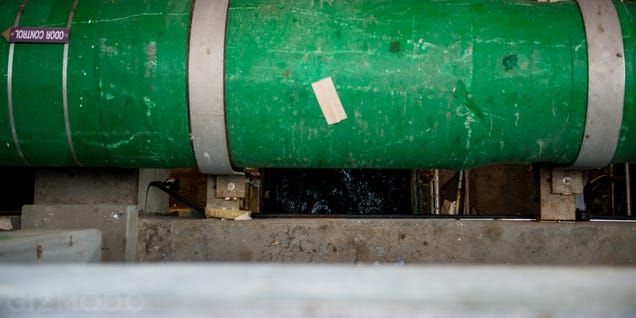
In Greenpoint, Brooklyn, the Newtown Creek Wastewater Treatment Plant borders Newtown Creek and Long Island City to its North. The facility opened in 1967 and, since then, has undergone several renovations and expansions—including its massive silver digester eggs—to accommodate NYC’s constant growth and evolution.
Oh and in case I wasn’t completely clear: It’s entirely full of shit.

Newtown Creek is the largest wastewater treatment plant in New York City, handling some 250 million gallons per day. Most of that wastewater comes from Greenpoint, Williamsburg, and downtown Manhattan through a unique combined sewer system.

Keeping out the trash
A combined sewer system means that street water and waste water from apartments wind up in the same sewer main. If that doesn’t sound like a great idea, that’s because it’s not, but a system like this is easier to build than one that separates the two. Unfortunately it also makes the process of cleaning New York’s expelled waste water more complicated than most cities. Because street water will end up in the pooptubes, garbage and other debris can cause damage to the treatment plants’ equipment. That’s where the sorting machinery comes in.

To make sure larger chunks of non-poop trash don’t get into the plant, the system utilizes several gates and screens to make sure only wastewater is entering the facilities. Sewer Overflow Regulators block floating trash from getting in by routing unfiltered water through pipes that block floating items while letting water (and poop) flow through unabated at the bottom.
Whatever makes it past this first defense is fished out with Mechanical Bar Screens, pictured above. Just like the Overflow Regulators, these screens filter the water that’s flowing through the top part of a pipe. A huge mechanized scraper periodically wipes off the bits of trash that get stuck to the screens. Meanwhile, the poops and wastewater keep flowing onward below.

After any trash is taken care of, the wastewater treatment process proper can begin. To start, the Newtown Creek facility utilizes things called degrittors and detritors. These machines essentially take solids (which is to say "poops") and smooshes them all together to take up a smaller amount of space in the waste water.

From there, the Newtown Creek plant tries to replicate the process that waste would undergo when breaking down naturally, except in a massive and controlled environment. After solid wastes are consolidated, the water enters secondary treatment area, where aerobic bacteria eats away at the poop and turns it into sludge.

After sludgification, the water reaches settling tanks that remove the sludge and floating scum. Water travels across a slight slope while unwanted poop particles rest along the bottom and get suctioned out. The sludge then travels back to the aeration tanks for a second pass while the water heads to a disinfection stage. In disinfection, concentrated bleach is poured in, after which the no-longer-poopy-poop juice is released into Newtown Creek as clear and fresh smelling water.

Tough shit
The Newtown Creek facility’s aeration tanks do a pretty good job of breaking down poop into sludge, but when the sludge can’t be broken down any further, it’s spun into a thicker solid and sent to one of the facility’s eight massive digester eggs.

Each egg basically acts as a stomach where poopsludge can be "digested" for 15 days. Inside the eggs are more anaerobic bacteria that further the process in a balmy 98 degree poopvironment. Just like in the human body, the breakdown of waste produces a methane gas byproduct, but this methane is used to power the plants boilers instead of going into farts.

Above the massive digester eggs is a walkway that wraps around the whole complex, providing a great view of northern Brooklyn, Long Island City and the Manhattan skyline from atop the tanks of shit. It’s a view you can see for yourself: the Newtown Facility is open for tours, and they’ll take you up on the eggs if you go.

Even these massive digester eggs can’t process everything though. After digestion there is inevitably some sludge waste that just can’t be broken down. This tough shit is transported to a separate facility by poopboats. Once there, its dewatered and turned into a thick, spongy solid and ultimately is delivered to a landfill.

Touring the facility from start to finish, I was struck by one thing in particular: The place doesn’t smell bad. Because emissions are mostly captured inside a set of tanks, the grounds smell at least as good as the rest of Brooklyn. I’m not completely sure how the open-air poop-sludge pools manage not to smell, but they don’t! It’s really impressive how little odor there is.

Poop jokes aside, without facilities like Newtown Creek our waterways would be horrible. The Newton Creek plant and the people who man it manage to turn millions of peoples’ waste back into into clean, environmentally safe water. They don’t even mind it! What they do mind though is litter.
A small piece of trash that sneaks by the facility’s defenses can easily break the whole, complex system. When a machine breaks it can costs thousands, if not millions, of dollars. So think twice about what you throw down to toilet—and don’t litter in the street. Somebody has to deal with that shit.

via Gizmodo
Where New York City’s Poop Goes